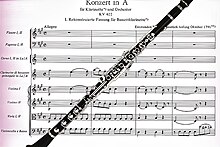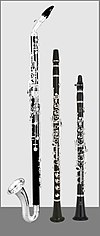Clarinet Concerto (Mozart)
This article needs additional citations for verification. (January 2018) |
| Clarinet Concerto | |
|---|---|
| by W. A. Mozart | |
 Score with basset clarinet (Leitner & Kraus) | |
| Key | A major |
| Catalogue | K. 622 |
| Style | Classical period |
| Composed | 1791 |
| Movements | 3 |

Mozart's Clarinet Concerto in A major, K. 622, was written in October 1791 for the clarinetist Anton Stadler. It consists of three movements, in a fast–slow–fast succession:
- Allegro (in A major and in sonata form)
- Adagio (in D major and in ternary form)
- Rondo: Allegro (in A major and in rondo form)
History[]
As there is no autograph for this concerto and as it was published posthumously, it is difficult to understand all of Mozart's intentions.[citation needed] The only relic of this concerto written in Mozart's hand is an excerpt of an earlier rendition of the concerto written for basset horn in G (K. 584b/621b).[1] This excerpt is nearly identical to the corresponding section in the published version for A clarinet.[1]
Mozart originally intended the piece to be written for basset horn, as Anton Stadler was also a virtuoso basset horn player, but eventually was convinced the piece would be more effective for clarinet.[citation needed] However, several notes throughout the piece go beyond the conventional range of the A clarinet; Mozart may have intended the piece to be played on the basset clarinet, a special clarinet championed by Stadler that had a range down to low (written) C, instead of stopping at (written) E as standard clarinets do.[1]
Even in Mozart's day, the basset clarinet was a rare, custom-made instrument, so when the piece was published posthumously, a new version was arranged with the low notes transposed to regular range.[citation needed] This has proven a problematic decision, as the autograph no longer exists, having been pawned by Stadler, and until the mid 20th century musicologists did not know that the only version of the concerto written by Mozart's hand had not been heard since Stadler's lifetime.[1] Attempts were made to reconstruct the original version, and new basset clarinets have been built for the specific purpose of performing Mozart's concerto and clarinet quintet.[2][3]
Music[]
The modern scoring of the work is for solo clarinet in A, two flutes, two bassoons, two horns (in A and D, often transcribed for horns in F),[citation needed] and strings.
|
| ||
I. Allegro[]
The concerto opens with a sonata-form movement in A major. The form of the movement is as follows:
- Orchestral ritornello: bars 1–56
- Solo exposition: bars 57–154
- Ritornello: bars 154–171
- Development: bars 172–227
- Ritornello: bars 227–250
- Recapitulation: bars 251–343
- Ritornello: bars 343–359[4]
The first theme begins an orchestral ritornello that is joyful and light:
It soon transforms into a flurry of sixteenth notes in descending sequence, played by the violins and flutes while the lower instruments drive the piece forward. After the medial caesura, the strings begin a series of canons before the first closing theme, featuring first and second violins, enters. The second closing theme is much more subtle until the fanfare of its final two bars. As the soloist enters, the clarinet repeats the opening theme with the expected added ornamentation. As the orchestra restates the main theme, the clarinet traverses the whole range of the instrument with several flourishes.
The secondary theme begins in the parallel minor, and eventually tonicizes C major before arriving in the dominant key, E major. At the end of the E-major section, there is a short pause, where the soloist conventionally improvises a short eingang (cadenza), although no context is offered for a true cadenza.[4] The canonic material of the opening ritornello returns, this time involving the clarinet and leads to the novel feature of the soloist accompanying the orchestra with an Alberti bass over the first closing theme. The orchestral ritornello returns, ending with the second closing theme.
The development section explores a few new key areas including F♯ minor and D major, and even has some hints of the Baroque. Before the formal orchestral ritornello leading into the recapitulation, Mozart writes a series of descending sequences with the cellos and bassoons holding suspensions over staccato strings.
As is conventional in Classical concerto form, in the recapitulation the soloist and orchestra are united, and the secondary theme is altered to stay in the tonic. As the secondary theme comes to a close, the clarinet has another chance to improvise briefly, and this time leads the canonic material that follows. The Alberti bass and arpeggios over diminished chords for the soloist recur before the movement ends in a cheerful final orchestral ritornello.
The solo exposition of this movement appears in almost every professional orchestral clarinet audition.
II. Adagio[]
The second movement, which is in rounded binary form (i.e. ABA'), is in D major. It opens with the soloist playing the movement's primary theme with orchestral repetition:
The B section, in which the solo part is always prominent, exploits both the chalumeau and clarion registers. The only true cadenza of the entire work occurs right at the end of the B section, immediately before the return of the A section. There are some passages that exploit the lowest notes of the basset clarinet in the B section.
III. Rondo: Allegro[]
The concerto ends with a movement in A major. This movement is a blend of sonata and rondo forms that Mozart developed in his piano concertos, most notably the A major Piano Concerto, K. 488.[5] It is in ABACABA form, with the middle A's being shorter restatements of the theme, unlike regular rondo form which is ABACA.
The movement opens with a cheerful theme:
This refrain is interspersed with episodes either echoing this mood or recalling the darker colours of the first movement:
- The first A (bars 1–56) features the soloist in dialogue with the orchestra, often one phrase eliding seamlessly into the next. In some ways the orchestra and soloist are competing with one another —the more definitive the statement made by the orchestra, the more virtuosic the response by the clarinet.[4]
- The first B (bars 57–113) begins with a lyrical theme, and eventually features chromaticism and some very dramatic lines which feature the extended range of the basset clarinet.
- The second A (114–137) is heard again briefly, before the orchestra moves right into the closing theme of the original A section, this time employing a descending sequence and hemiola, modulating to the relative minor.
- The C section (bars 137–177), according to scholar Colin Lawson, contains "one of the most dramatic showcases for the basset clarinet in the entire concerto, featuring spectacular leaps, together with dialog between soprano and baritone registers."[4] Starting in F♯ minor, this section eventually modulates back to A major.
- Measures 178–187 serve as the third A. By no means a full statement of the refrain, in this section Mozart sets the motif from the A section as a sequence of descending thirds leading to a stop on the dominant chord.
- The second B (bars 188–246) begins like the first but is extended and explores some different key areas. This allows the soloist frequent opportunities to display chromatic figurations, and the composer to demonstrate his creativity in the reworking of the material.[4]
- The refrain (bars 247–301) is heard for the final time, finally in its entirety, before proceeding to the coda (bars 301–353). Here the rondo theme is developed dramatically, using the full range of the clarinet. The coda builds until a brief pause allows the solo clarinet to lead the orchestra into one more extended statement of the A theme, followed by the orchestra's now familiar closing theme of A.
Reception[]
Stadler played the concerto at its premiere in Prague on October 16, 1791, and his performance was favorably received.[citation needed] Without mentioning Mozart's work, the Berlin Musikalisches Wochenblatt noted in January 1792, "Herr Stadeler, a clarinettist from Vienna. A man of great talent and recognised as such at court... His playing is brilliant and bears witness to his assurance."[4] There was some disagreement on the value of Stadler's extension; some even faulted Mozart for writing for the extended instrument.[citation needed]
In recent years, the restored original version has been recorded by many artists.[citation needed]
Selected recordings[]
References[]
- ^ Jump up to: a b c d Hacker, Alan (April 1969). "Mozart and the Basset Clarinet". The Musical Times. 110 (1514): 359–362. doi:10.2307/951470. JSTOR 951470.
- ^ Ness, Arthur (1963). The Original Text of Mozart's Clarinet Concerto. Cambridge, Massachusetts: Master's thesis, Harvard University.
- ^ Adelson, Rob (Fall 1997). "Reading between the (Ledger) Lines: Performing Mozart's Music for the Basset Clarinet". Performance Practice Review. 10 (2): 152–191. doi:10.5642/perfpr.199710.02.03.
- ^ Jump up to: a b c d e f Lawson, Colin (1996). Mozart: Clarinet Concerto. Cambridge, England: Cambridge University Press. ISBN 978-0-521-47929-5.
- ^ Rosen, Charles (1997). The Classical Style: Haydn, Mozart, Beethoven. New York: W. W. Norton. ISBN 0-393-04020-8. OCLC 35095841. Retrieved 2008-01-13.[page needed]
External links[]
| Wikimedia Commons has media related to Clarinet Concerto (Mozart). |
- Konzert in A für Klarinette und Orchester KV 622: Score and critical report (in German) in the Neue Mozart-Ausgabe
- BBC Discovering Music
- Clarinet Concerto (Mozart): Scores at the International Music Score Library Project
- The 1802 AMZ review of the Mozart Clarinet Concerto (German Original text with English Translation)
- 1791 compositions
- Concertos by Wolfgang Amadeus Mozart
- Clarinet concertos
- Compositions in A major


